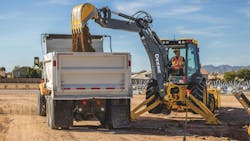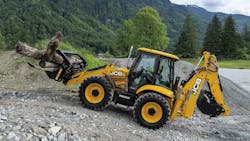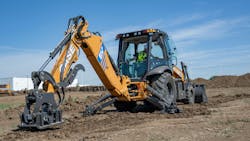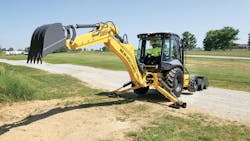Key Highlights
In this article, you will learn:
- Recent innovations in backhoe loaders.
- How manufacturers are balancing added technology with cost considerations.
- How attachments for backhoe loaders are evolving.
- Current operator comfort features.
Backhoe loaders have been in the market a very long time; James Gill, product manager at JCB, says the company invented the backhoe loader in 1953. For years they were the only choice for customers seeking a versatile, reliable machine. In recent times, compact equipment has stolen much of the market from backhoes, but that theft has stopped.
Backhoe loaders are firmly entrenched in the segments of the market they serve best, which includes municipalities, small construction companies, landscapers, rental houses, rural estate owners, agriculture, and cemeteries. Their versatility, familiar operation, and roadability keep them top-of-mind for these customers.
As compact equipment has become bigger, the prices have also grown.
Historically, their significantly higher initial cost drove some customers to choose other equipment, but that price gap has been altered. As compact equipment has become bigger, the prices have also grown. And as backhoe manufacturers have added performance and features to some models, they have also introduced lower-cost models with fewer features and somewhat lesser capabilities. The price difference between a large compact machine and a “budget” backhoe may be virtually nonexistent, and buying the backhoe gives you the versatility and transportability the compact machine likely lacks.
Current technology offerings on backhoe loaders
Technology is making inroads to backhoe loaders from two sources. One is the tech that’s shared across the equipment market, things like depth indicate systems, operating modes, and telematics. The other is tech specific to the use of attachments, including joystick controls, proportional flow to drive and auxiliary circuits, and advanced connectors and attachment points.
George MacIntyre, product manager backhoes and tractor loaders, Case Construction Equipment, says, “We believe we have introduced the latest technology to backhoes with the commercial launch of the industry’s first electric backhoe loader, the 580EV, in 2024.” Powered by a 400-volt lithium-ion battery and electric motors, the 580EV delivers energy to both the ground drive and hydraulic systems.
Historically, technological progression has been slower for backhoes than for many types of equipment. This is partly because not all high tech is a good fit for backhoe use. No one’s clamoring for 3D machine control for backhoes. It’s also because backhoes are fully evolved to do what they’re intended to do; there aren’t performance gaps in need of filling with advanced technology.
So yes, technology is coming to backhoes but in a measured, selective way. With other equipment, it’s often assumed more is better. More tech. More attachments. More applications. With backhoes, more of anything is closely scrutinized to make sure the use case justifies the change.
What attachments can a backhoe use?
The attachment market is often focused on ways to enable equipment to do things for which it was not originally intended. Rock saws, compaction tools, and hammers/breakers allow excavators to escape a life devoted to digging. Countless attachments exist for compact equipment.
With backhoe loaders, attachments have historically been designed to add performance and nuance to what they already do. Bucket options, such as width of bucket and teeth vs. cutting edge, optimize backhoe functionality, and clamshell, 4-in-1, and 6-in-1 buckets plus forks improve loader performance. The addition of a thumb to the backhoe dipper was about as radical as attachments went. Backhoes were designed to be efficient within a specific range of applications, and customers bought them for those applications; there was no perceived need for further versatility.
The infrastructure was not in place to run attachments, things like hydraulic lines and electrical connectors. Nor was there sufficient hydraulic performance to run larger attachments that came into the market, since backhoe loaders’ hydraulics were designed to serve only the needs of the backhoe itself.
There are exceptions. Kubota’s models allow the use of attachments via a rear PTO and 3-point linkage.
New Holland Construction offers the B95D Tool Carrier model. It has two lift cylinders on the loader, rather than one cylinder in the middle, which improves visibility to the front of the machine. It also has a horizontal pin coupler for faster and easier attachment change-outs. There are trade-offs. The two non-Tool Carrier versions of the B95D have better visibility to the corners of the bucket, greater lift capacity, and more breakout force.
Brooms and snow removal attachments have found their way to the backhoe market. according to Dan Kakareka, New Holland Construction product marketing manager. He says there is interest in three-spool hydraulics on the loader end and bidirectional hydraulics on the backhoe. Even so, backhoes will likely never be the preferred host machines for attachments in large part because of their limited maneuverability when compared to smaller machines, especially those with counter-rotational steering.
MacIntyre says that Case backhoes have many features that improve the operator experience. Comfort Steer halves the number of turns lock-to-lock to reduce steering effort and make it easier to maneuver in tight spaces. PowerLift boosts hydraulic relief pressure to the backhoe while also limiting engine speed for greater lift capacity with enhanced precision. PowerBoost provides a 4-second surge of hydraulic power without altering engine rpm for tough tasks such as breaking through roots or frost. ProControl eliminates boom rebound during backhoe operation. Auto Ride Control minimizes “porpoising” during travel. Over-Center Backhoe Design transfers more weight from the backhoe to the front axle for enhanced traction and reduced bouncing when roading.
Three of Caterpillar’s center-pivot backhoe loaders (BHLs), the 420 XE and their two largest models, the 440 and 450, incorporate electrohydraulic systems across all hydraulic functions. This enables such advanced features as dual-mode operation, various hydraulic flow control, and other software-driven capabilities. “Currently, Caterpillar is the only manufacturer offering this level of electrohydraulic integration in BHLs in North America,” says Caterpillar product consultant Brian Nobles.
JCB has updated its 3CX and 4CX models and offers four versions. The 3CX is its basic unit, offering backhoe loader versatility at a lower initial cost. The 3CX Plus has greater dig depth and enhanced loader performance. The 3CX Pro has all the performance of the 3CX Plus with greater speed (30 versus 25 mph). The 4CX Pro has all-wheel steer for optimal maneuverability. All have JCB’s Command Plus Cab for enhanced visibility and comfort. All are available with center-mount backhoe; sideshift mounting is available on the 3CX Pro and 4CX Pro. The center-mount machines have a new outerbox material handling dipper stick and thumb design for improved grabbing power and better weight distribution. The sideshift models feature an innerbox excavating dipper stick for maximum reach and digging power. All have a 4.4-liter engine, rated at 79 horsepower on the 3CX and 109 horsepower on the other three models.
John Deere brought their backhoe loaders into its tiering structure several years ago. The lineup consists of the 310 G Tier, 310 P Tier, 320 P Tier, 410 P Tier, and the 710 P Tier. Emily Pagura, product marketing manager, John Deere, says the line received a recent refresh with notable changes to the cabs. There are fewer pillars and those that remain have been repositioned; the net effect is improved visibility. Leg room is increased by 5 inches when pivoting between work stations. Controls are located higher on the B pillar. The rear window is more excavator style with a small, fixed bottom panel and two upper panels that can overlie each other and be slid overhead. There are new seating options and HVAC has been refined. An optional rear camera package uses two cameras, one in each upper corner, plus a dedicated 8-inch monitor. The operator can select either camera view or one wide view using both cameras for an unobstructed view.
Kubota refers to its backhoe loaders as “tractor loader backhoes” (TLBs), and the chosen nomenclature is not a whim. Kubota has an extensive line of tractors for many markets, and their tractor heritage is retained in their TLBs. Gracie Martin, Kubota product marketing specialist for compact utility tractors and TLBs, says removal of the backhoe is easy and provides customers with the use of a traditional tractor rear PTO and optional 3-point linkage. By enabling use of PTO-driven attachments, including those common in agriculture, the design further expands the versatility of Kubota TLBs beyond that of backhoe loaders without that feature.
New Holland’s backhoe product line is mature following years of refinement. The big change came in August 2025 when telematics, which had been optional, became standard. More than that, the standard package now includes preventive maintenance features and an app to integrate telematics for all of a customer’s properly equipped New Holland equipment. Eco mode, auto idle, and auto shutdown also became standard. Auto idle comes in after 5 seconds of no hydraulic input. Auto shutdown delay is user settable in increments of minutes. Bidirectional auto-levelling is also now standard after having been standard only on the lift cycle. Float will remain a standard feature.
About the Author

Richard Ries
Richard Ries began his free lance journalism career in June, 1985, calling on his experience as a service manager at a Honda motorcycle dealership to place his first article. When the motorcycle market collapsed in the late 1980s, he moved to the booming bicycle market. Finding that market lacked the professionalism he sought, he moved to construction in 1995 and has remained there ever since.
His countless clients have included entities in Australia, England, France, Germany and Scotland. He has written for trade and consumer periodicals, equipment and component manufacturers, government agencies and non-governmental organizations. Clients have also commissioned him for photography and videography work, either stand-alone or as part of package of text and images.





